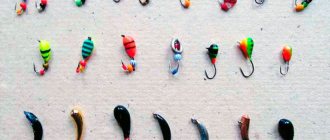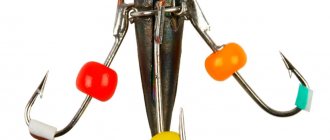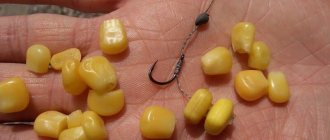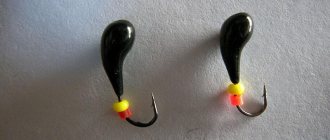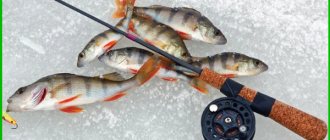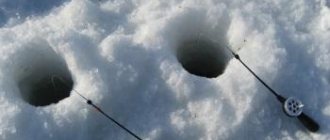Definition of goat jig
The goat jig, also called the “goat-dereza” and “kozochka” , is a jig for baitless fishing, equipped with two hooks.
This bait got its name because of its resemblance to the head of a domestic animal. The principle of operation of a goat jig is to imitate the movements of a small aquatic invertebrate or, when using large “goats”, a small fry.
Options
Form
Although the general design of the goat jig is basic, there are nevertheless many modifications of this bait. Most often, “goats” resemble the well-known “Uralki” in shape. The bait can be elongated or shortened, straight or curved, and therefore the action of the jig changes. Different modifications are designed for different fishing conditions and for catching different types of fish.
Size
The length of goat lead jigs ranges from 8 to 12 mm, and the width rarely exceeds 3 mm. Naturally, tungsten jigs with a similar mass are smaller in size.
Material of manufacture
Most goat jigs are made from lead and tungsten. Soldered jigs have a crown made of non-ferrous metal (copper, brass, cupronickel) and a body made of solder. If jigs are made by winding wire around the shank of a hook, use tin or, for very light “goats,” copper wire.
Color
The most popular color of goat jigs is black . Black jigs are usually used with additional decorations. Catching baits are jigs with a crown made of non-ferrous metal without any additional elements. For certain reservoirs, the use of red and green jigs can be effective.
Additional items
It is customary to catch perch and other predators using jigs without any additional elements.
To catch roach, bream and other white fish, “goats” are equipped with beads or cambrics . Contrasting colors of the main bait and the additional element are encouraged, i.e. with a black jig it is better to use white and yellow decorations. An interesting option would be to equip different jig hooks with elements of different colors, say yellow and red. Ultimately, the angler himself decides whether to use additional decoration or not, and the same applies to the choice of color.
Varieties
Goat Pierce drop
These jigs are manufactured industrially from tungsten.
They have a short body and are used without additional elements. The jigs are not painted. Thickened hooks are used, designed for catching large fish. The large specific gravity of jigs allows them to be used for fishing in currents.
Goat bug
Low-frequency lure, also made of tungsten. It is optimal to use “Klopik” on the last ice , when the perch no longer reacts so willingly to jigs that move with high frequency.
“Klopikov” are often equipped with one large bead, which is fixed with a cambric.
Goat banana
The shape of the bait resembles this fruit.
Made from lead and tungsten, it can be used with or without additional decorations. The “banana” goat can be tied in two ways : by the ring at the end of the bait and by the shank of the hook, after passing the fishing line through the eye.
At the same time, the position of the bait in the water changes and, accordingly, its game.
Mormyshka without an ear
The greatest difficulties are presented by models that do not have a ring. They have a through hole in the body of the bait. Typically, breaks occur due to the fact that the fishing line frays on the uneven edges of this hole. The problem is solved by pulling the cambric. But the hole is too narrow; simply inserting a cambric into it will not work. And this is done like this:
- Heat the cambric in hot water.
- Gently stretch a piece about 2 cm long.
- Cut the edge diagonally.
- Pass the cut through the hole.
- Pull so that the unstretched cambric enters the body of the jig. It will fill the hole tightly.
- Cut off the excess, leaving approximately 1 mm from the edges on both sides.
- Using a lit match, heat the ends until they melt a little and become smooth.
Now you can tie the bait. To do this, we use one of the most reliable and simple nodes:
- From the side of the hook tip, we pass the fishing line through the hole.
- We make a loop and press it with our fingers to the fore-end.
- Wrap the free end around the hook and pressed loop 7 - 10 times.
- Pass the fishing line through the loop, tighten the resulting knot well, not forgetting to wet it.
In this way you can quickly tie everything you need, even in the cold. It will be in the correct position, and thanks to the cambric, the line will not fray.
What kind of fish can you catch?
You can catch the following types of fish with a goat jig:
- Perch. Perch is extremely partial to the high-frequency “goat” game. Most often, the striped robber is caught using jigs that are not equipped with either beads or cambric. Sometimes, to make the bait more attractive, a short piece of red woolen thread is tied to the hook.
- Pike perch. Pike perch are caught on large “goats”. It should be taken into account that with baitless jigs it is not recommended to use a fishing line thicker than 0.14 mm and be prepared for the fact that it will not be possible to cope with a large predator.
- Bream. Bream bites on black and red baits with or without additional decoration on the hook. Playing with a jig should be relatively low-frequency.
- Roach. To catch roach, small “goats” are used, which are played at a moderate pace.
You can also catch ide, chub, silver bream and dace with a goat jig.
Universal "goat"
Photo by the author
Until a certain moment, I was firmly convinced that in reelless fishing the degree of versatility of the devil is greater than that of a jig or a goat. But recent fishing has debunked the cult of the universality of the “devil.” On one of the fishing trips, a goat shot.
The task of choosing a smaller bait or a larger one is quite difficult in itself. It would seem that if in shallow waters you can get by with a smaller jig, why not do this? Especially when the fish is mischievous and does not rush at everything that moves. On the other hand, in our latitudes there are still enough large fish to avoid “messing with” them by using a 0.08 mm fishing line. And if so, why not try fishing with larger jigs both at depth and in the shallows from under the ice?
Before going to the reservoir, I equipped one fishing rod with 0.16 mm fishing line and tied a fairly heavy goat. In fact, according to the plan, the main object of fishing was supposed to be a bream, the size bordering on bream, which our friend regularly does not drag to the hole in the ice. To catch something like this, I had proven fishing rods with devils and jigs. I made a new fishing rod with a goat in order to chase perch. Look for it both at depth and in the shallows, on the border with algae.
As often happens, the bream bite was yesterday and, perhaps, there will be tomorrow. The experienced “penguins” settled down in their treasured holes, fed and became quiet. I immediately had an intrigue - in the very first hole, a perch first sat on the jig, and soon after a barely noticeable delay in the nod, I pulled the jig out of the mouth of some large fish. But it didn’t work out. This fact greatly inspired me. There are fish under the ice. I turned several holes nearby and immediately fed both the old hole and the new one. This brought me one whiting, that's all. I also drilled an interesting dump, caught several perches with a devil, but the sluggish bite spoke in favor of the fact that today is generally a day when no one bites. I decided to try my luck near the shore, where muddy spots of old holes could be seen. And just in time!
Goat, on stage!
Taking out my new fishing rod with a massive goat from the Minotaur, I began fishing with a silicone ball. Again I experienced the disappearance of some large fish. I check the next holes. On the second I catch gray salmon of a nice size. So, it wasn’t just perch that was being hunted here? Very interesting! The fact that a goat pecked at a goat is not news to me. On the Karpov Reservoir, I have already caught a full-length roach with it. But only perch and roach. And here comes a surprise! Walleye?! On the rocks?! In general, I continue to catch goats. There are 4 fish in a row on the third hole. Perch, roach and two striped brothers weighing 300 grams each. Well, that's it! I found a fish, I’m alone on the lists, I try not to fuss, I hide the fish in a box. Well, the “goat to heaven” rushed. Serukha in an honest palm, bites, insolent presses of a nod, gatherings... the drool was already flowing, because there was no time to be distracted by swallowing them. I decided to catch another goat, such a brilliant one, but without any bait - zero! Again I went back to the old goat with a soft silicone ball on one of the hooks. This is where the others figured me out.
Not to say that drilling scared the fish away. One or two pieces continued to be caught from each hole. The zander flew in again, but this time it was small, 300 grams. And the breeze died down to a weak one! The snow began to fall. Lapota! Now I can clearly see the careful touches from the nod. It seems like a small thing, but after another “hooking on the lips” I come to the understanding that the fish under me is large, but very harmful. I'm starting to experiment with wiring.
My friend Misha couldn’t stand it and took the second, last, exact same goat from me. Without saying a word, he went to his hole and ten minutes later he caught a bream. Is the ore gone?! Those who drilled many new holes for us were already reaching out to the cars, complaining about the change in wind and pressure. In the meantime, a serious bream landed on me and somehow already on the ice tore off a catchable goat. Apparently, the small pike perch have done their fanged work. While I was carefully examining the fishing line and carefully tying the goat, I smelled something wrong from behind. It turns out that it was not a shoemaker or a boatswain during an emergency, it was a bream that tore off Misha’s magic goat.
Already on the way home, we came to the conclusion that the most effective retrieve, which forced large fish to bite, was a slow rise without oscillations, then a rise with oscillations of the highest frequency and minimum amplitude. It was this combination that provoked young bream. True, one question still bothered me - why didn’t the proven devils work today, but the big goat did? Maybe this year?
Andrey Koltsov January 30, 2015 at 12:49 pm
Tackle
No-bait fishing requires that the gear meet certain requirements.
Fishing rod
The most convenient is the balalaika fishing . The reel should rotate freely, and the handle should be made of “warm” materials: foam or cork.
fishing line
To catch a goat with a jig, a fishing line whose diameter does not exceed 0.14 mm , otherwise the bait cannot be animated as it should. As a rule, monofilament is used, less often fluorocarbon.
Nod
The nod is the most important element of the tackle. With the help of a nod, vibrations of the required frequency are given to the jig. The material used for the nod is lavsan or a clock spring . The nod has a taper. The length of the nod reaches 20 cm. The nod for catching perch must ensure play with the jig with a frequency of at least 300 vibrations per minute; for catching “white” fish, this value is significantly less.
Expert opinion
Knipovich Nikolai Mikhailovich
Zoologist, hydrobiologist. I am interested in fishing at a professional level.
Important! Tackle for fishing with a goat jig should be balanced and versatile. By changing only the length of the nod, you can play with the jig at different frequencies, adapting to the mood of the fish in a particular place at a given moment in time.
How to tie a jig with an eye
You can often hear that the bait breaks off. The reason may be the fishing line. If it is too hard or thick, the break occurs right at the knot. Another important point is that the line must be moistened before tightening; If this is not done, even a small perch will be able to tear off the bait.
The jig is tied like this:
Another knot called “clinch”:
This is the “clinch” knot; it is universal, as it is used for equipping winter and summer fishing rods, for tying any baits and elements of gear with a ring.
Before fishing, it is advisable to practice so that you not only know how to quickly and reliably tie any jig with an eye, but also can do it almost blindly. The knots are very simple, anyone can master them.
Technique and tactics
The tactics of fishing with baitless jigs are more reminiscent of winter trolling than traditional fishing with jigs and animal bait . Catching predatory fish involves searching for promising places, tracking down schools of perch and pike perch, and fishing several horizons to determine exactly what the fish is currently occupying.
Catching “peaceful” fish is more passive, however, even such fishing will not do without constant movements. Only when a school of roach or bream is found, you can feed the hole and begin leisurely fishing, however, constantly selecting the optimal game with a jig .
Expert opinion
Knipovich Nikolai Mikhailovich
Zoologist, hydrobiologist. I am interested in fishing at a professional level.
Attention! Winter echo sounders are very useful for ice fishing. The movements of the jig and how the fished object reacts to them are clearly visible on the device’s screen. If necessary, you can change the jig or its animation, and if there is no fish, change the place.
The fishing technique for all baitless jigs is fundamentally similar. The bait should be given high-frequency vibrations using a nod. Depending on the type of fish the angler is aiming to catch and its activity, the game with bait should be varied.
Typically, fishing with a baitless jig is carried out as follows:
- Drill a hole and clear it of ice chips;
- lower the jig to the bottom, not forgetting to tap it on the bottom several times;
- begin to lift the jig, playing with it and making short stops;
- at the top point of the wiring, pause for 5-7 seconds;
- lower the jig;
- pause at the bottom of the wiring;
- the cycle is repeated several times.
We should not forget to fish not only the bottom, but also the upper layers of water. The amplitude of the bait play when fishing with a baitless jig is just as important as the frequency. If there are no bites, they move to another hole.
On the river
On the river, the retrieve must be accelerated, since the current does not allow the fish to properly examine the bait. Jigs should be heavier.
On the lake
Fishing on the lake involves using lighter jigs. You can take longer pauses, since a stationary jig cannot be carried away by the current.
Fishing technique
The effectiveness of the goat, just like other baitless baits, depends on the game. The principle of operation is the creation of acoustic waves of a certain frequency and amplitude, to which the fish reacts.
The goat is characterized by a specific game. The game is quite monotonous compared to other jigs, however, this does not make it simple at all.
The game is played quickly and widely with a vertical lift. The game will resemble the movements of the sawing process with a jigsaw. During the retrieve, it is important to change the lifting speed, and at the very end, hold the bait for a couple of seconds. White fish very often bite at this moment.
You should not raise the goat higher than 0.5 m above the bottom.
At first glance, everything is very simple , however, in practice, not everyone can play fast and aggressively. It will take some time to master the game.
It is worth noting that fishing with a goat is often significantly less effective than with another jig. The reason is that the simpler single hook design is much easier to play. Therefore, novice fishermen should still first master other nozzle-less jigs. Preferably at a time when the fish are most active.
